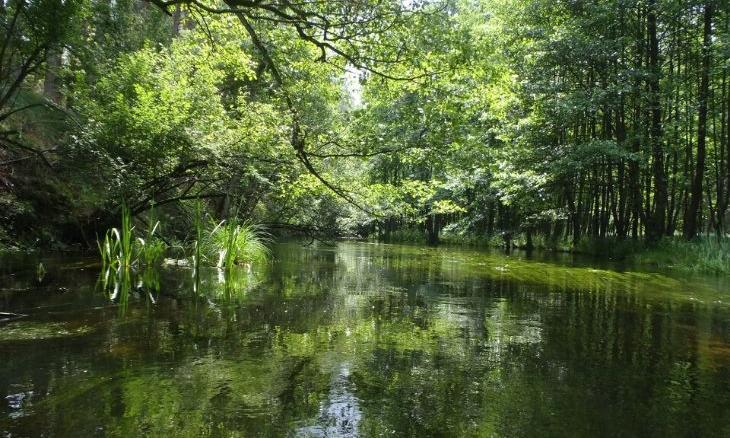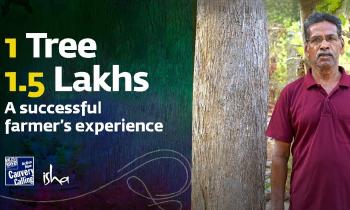Agroforestry: The Future of Farming
It’s now acknowledged globally that nature-based solutions are the only sustainable solutions for ecological challenges. Technology and engineering can offer short-term solutions. Only sustainable practices such as agroforestry can reverse manmade ecological crises.

Indian rivers and Indian soil have been depleting at a rapid rate in the past few decades due to various factors like deforestation, pollution from point and non-point sources, and climate variation. One such major river is the Cauvery, which has depleted by 40% in past decades and poses a big threat to water and food security of the region. Cauvery’s revitalisation can transform the lives of 84 million people who are dependent on the river in some way. India’s 3rd and 6th largest cities in terms of population, Bengaluru and Chennai with a total population upwards of 15.5 million people, depend primarily on Cauvery for their water needs. In 2019, Chennai went completely dry, to the extent that drinking water had to be transported via railways to the city.
Parallely the country is undergoing a deep and disturbing agrarian crisis; conventional agriculture with cash crops is becoming economically and ecologically unviable. Farmers have the closest interaction with soil and water - they use 90% of the extracted groundwater. Naturally, they are the hardest hit by the current soil and water crisis. Tree-based agriculture or agroforestry is a nature-based solution that can effectively combat the crises.
Cauvery Calling is a first of its kind campaign, setting the standard for how India’s rivers – the country’s lifelines – can be revitalized. It will initiate the revitalization of the Cauvery river by supporting farmers to plant 242 crore trees in the river basin. This will increase water retention in the basin, while enhancing farmers’ income by 300 to 800% in 5-7 years and transforming the lives of 84 million people. The presence of trees will enrich depleted soil and recharge groundwater levels and sequester an estimated 9 to 12 trillion liters of water in the Cauvery basin, significantly contributing to increase the source flow of the river.
Farmers across the country are practicing conventional agriculture with a focus on cash crops because that’s where the money is. Unless tree-based agriculture fetches similar or higher returns, it is unfair to expect farmers to plant trees. In Tamil Nadu 69,760 farmers have seen these benefits with their incomes rising between 300 and 800% in a 5 to 7-year time span. More farmers are now enthusiastically taking up tree based agriculture on their farmlands.
For the farmer, agroforestry means improved incomes and lower risk from uncertain weather conditions, as trees have very high climate resilience. Agroforestry also frees up the farmer’s hands to spend more time off the farm in allied or alternative employment for additional income generation. The farmer can engage in small rural processing enterprises based on wood and other raw materials from trees.
Agroforestry - a proven model
The UN Food and Agriculture Organization has defined agroforestry as a name for agriculture where trees are grown along with agricultural crops and animals in a way that they benefit each other. It is a nature-based solution that improves both the economics and the ecology by the introduction of trees to the farmlands.
The presence of trees slows down rainwater before it hits the soil. Instead the water hits the leaves, slowly trickles down and is allowed to percolate into the soil facilitated by tree roots. This reduces the loss of the rich top soil to erosion by water.
Tree-based agriculture doesn’t require frequent tilling of the soil. The leaf litter and other organic waste from trees like rotting roots in the ground, increases soil health via addition of organic matter. This gradual increase in soil organic content not only improves the retention of moisture in soil, which is necessary for plant growth, but accelerates the recharge of groundwater by increasing the rate of percolation. Trees also provide shade to the land and help in creating an overall microclimate with lower temperatures and higher moisture content. As such, the presence of trees has a positive effect on the health and yield of other crops in the farm and the biodiversity in the soil.
It’s now acknowledged globally that nature-based solutions are the only proven sustainable solutions for our ecological challenges. Sustainable practices such as agroforestry can reverse manmade ecological crises. Agroforestry has been demonstrated successfully across the world and according to leading research institutes, Central Agroforestry Research Institute (CAFRI) and World Agroforestry (ICRAF) it has also been successfully demonstrated across the Indian geography as well, in the arid ecosystem of the western Himalayas, the semi-arid ecosystem of the central highlands and the coastal ecosystem of the Western Ghats. Its adoption in the current Indian scenario has the potential to mitigate the ongoing crises and bring about both economic and ecological well being.












